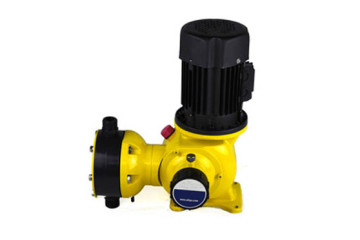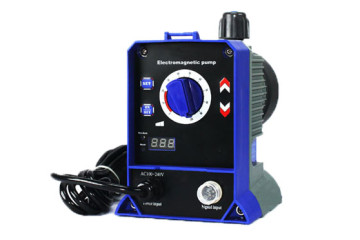Dosing Pump Introduction
A dosing pump is a kind of diaphragm pump with the diaphragm hydraulically or mechanically actuated. It is designed to feed chemicals or other liquid substances at a precise adjustable flow rate. The flow rates of most dosing pumps can be adjusted with a digital touch pad or a hand dial. The flow rates for dosing pumps are often low because of the nature of their applications, and most flow rates are rated in gallons per hour rather than gallons per minute like most pumps.
The flow rates for dosing pumps generally range from 0.001 gallons per hour to 20 gallons per hour, while the total head (pressure) ranges from 10 to 30,000 psi. Horsepower ranges from 0.125 to 5 horsepower. Although some dosing pumps can be used to pump water, they are generally used to pump solutions, chemicals and other fluids. Most of them are rated to have the ability to pump into a high discharge pressure. The dosing pump is typically designed to operate at practically constant flow rates within a wide range of outlet (discharge) pressure.
How it Works
There are two major types of the dosing pump, and each type may vary the flow rate by a variety of pumping mechanisms. A dosing pump that works through variable displacement varies the flow rate by changing the amount of liquid entering the pump, while the motor always operates at a constant speed. The pump does this by varying the stroke length or in some instances the amount of hydraulic fluid that is bypassed. A dosing pump that works by fixed displacement varies the flow rates by changing the motor speed, while a constant amount of liquid is displaced with every revolution.
Application
Dosing pumps are employed in applications where the flow rates of a fluid need to be precisely adjusted and measured on a regular basis. The pumps are commonly used for pumping water treatment chemicals such as drinking water, swimming pools, cooling towers, boilers, or in the treatment of wastewater. The chemicals used for treating water are pumped into the water in order to regulate the pH, alkalinity, as well as to disinfect the water.
Additionally, a dosing pump has various applications in food processing plants such as blending liquid ingredients, in pipelines to minimize the frictional losses as the oil is moving through the line, in several medical and laboratory applications, and in process metering applications where a certain chemical has to be mixed in precise amounts with another chemical.


